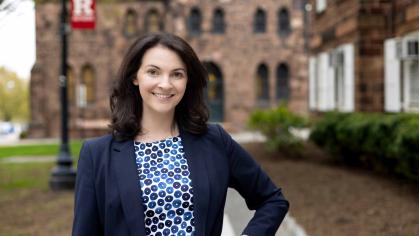Alumna’s Artwork Showcased on the Moon in Out-of-This-World Collection

Nanette Fluhr’s portraits are being included as part of a project in conjunction with NASA
Nanette Fluhr’s artwork has been featured in museums and galleries throughout the world and now a few of her pieces will be preserved on the moon.
Fluhr’s portrait of her son as a young baseball player was among a collection of digitized artwork sent to the moon on Feb. 22 as part of Lunar Codex project in conjunction with NASA.
By the time all six missions of Lunar Codex are completed – the final one scheduled for this November – 175,000 to 210,000 pieces of art, music, poetry, books, film and television representing 35,000 artists from around the world will be included. Fluhr, a Rutgers College alumna, will have 11 of her works among that massive collection, which will be on the spacecrafts in form of microfiche.

“It's just a thrill,” said Fluhr, a portrait artist from Matawan. “My first memory is my father waking me up to see Neil Armstrong take his first steps on the moon when I was 3. It’s especially meaningful to me to have my art permanently there.”
Lunar Codex is the brainchild of Canadian physicist and author Samuel Peralta, who is working with artists around the world to curate and send the works aboard space capsules. He is working in parallel with NASA’S Artemis campaign, which aims to land humans on the moon again in 2026.
“The Codex is a message-in-a-bottle to the future, so that travelers who find these time capsules might discover some of the richness of our world today,” Peralta said on the website. “It speaks to the idea that, despite wars and pandemics and environmental upheaval, humankind found time to dream, time to create art.”
The Feb. 22 landing of the unmanned Codex Nova space capsule had another distinction.
“This is the first time that women artists are represented on the moon, and I'm honored to be one of them,” Fluhr said.
In 1969, a minuscule tile, titled The Moon Museum, traveled with Apollo 12’s lunar mission. The piece, which is currently in the collection of Museum of Modern Art, is thought to be the first work of art to travel to the moon and displayed the works of six male artists, including Andy Warhol.
The digitized portrait of her son – a piece entitled Lonny – shows him as a Little Leaguer in a New York Mets uniform, getting ready to throw his next pitch. She painted it in 2012 for his Bar Mitzvah celebration.

Initially, it was not one of the pieces curated to travel to the moon. When a local television news story about Lunar Codex featured Fluhr, it included Lonny in the segment. Greg Prince, a Long Islander who writes a blog about the Mets, saw the news segment and contacted Fluhr. She forwarded Prince’s email to Peralta, who immediately replied, “Let’s get Lonny on board!” Prince wrote a blog post about the encounter. That post, Moonstruck, is now also moon-bound.
Fluhr’s 11-piece collection that will end up on the moon covers her work spanning 30 years from 1993 to 2023. Over the course of her career, Fluhr’s works have been part of public and private collections worldwide and have been featured in several industry publications, including PoetsArtists and Fine Art Connoisseur. The editors of those publications are among the curators working with Peralta to select the pieces for Lunar Codex and they used the works that appeared in their archived issues.
The works that were selected, however, were particularly meaningful to Fluhr, such as the portrait of her grandfather she sketched in 1993. “It was my breakthrough piece,” she said. “The painting was the first I ever entered in a show, and it won the award of excellence. It also placed among the top 10 in the country in the Artist Magazine 1995 competition and was featured in their magazine. He was always so proud of my art. He took the magazine with him on his daily walks and would show it off to everyone he saw. I love that a piece of him will be preserved.”
As a portrait artist, Fluhr said that she’s preserving family legacies, but Lunar Codex is preserving humankind’s creativity.
“Art is a visual language,” she said. “It lifts us and it’s our shared humanity.”




